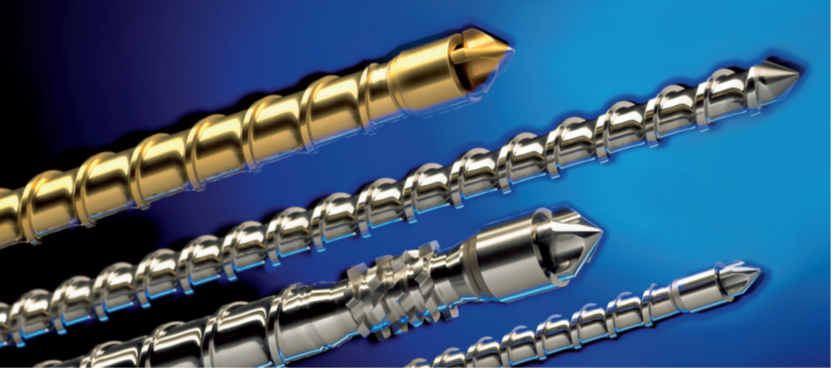
May 4, 2023
Screw Design for Sustainability

Sustainability in plastic processing involves optimizing the screw design to reduce material waste, energy consumption, and environmental impact.
With the following key considerations, it is possible to design screws that are more sustainable, reducing waste and minimizing environmental impact while still delivering high-quality plastic products.
How can we reduce our impact on the environment?
When we think of Sustainability, we often think of ways that we can reduce our impact on the environment, and how we can be more efficient in what we do so, we use fewer resources to accomplish our tasks. When we swing over to manufacturing, the thought is, how do we use less energy, how do we use renewable resources to reduce our impact on the environment again?
When discussing energy-saving measures on older machines, we look at how we can improve in areas we control. Older hydraulic presses have pumps that run continuously whether a product is being produced or not. A newer hydraulic press can throttle back its pumps based on downstream requirements. Possibly a hybrid where you use a mixture of Hydraulic and Electric options and then total electric, so you only use energy when energy is required.
Reiloy USA supports both the OEMs and End Users. It looks at how a properly designed screw is optimized for the resins being processed and married to a heat profile that helps optimize the screw design’s functionality, allowing processors to apply the appropriate energy level without overworking the machine or resin.
Unless otherwise specified, a new molding machine will be delivered with a typical 3-zone general-purpose screw. It will convey, melt, and allow you to mold a product, but it is general purpose in nature and is not designed to take specific application needs into account.
Examples: When running a base resin with pellet colorant (salt and pepper), there is nothing on a 3-zone GP screw to optimize the mixing action of a salt and pepper mix, so in turn back pressure is increased, screw rpms are increased, all requiring additional energy to try and get colorants to mix, but often the scrap rates increase due to the lack of mixing capability and the inefficiencies begin to pile up.
Additional example: You have an application where you are using a large portion of your available shot capacity, and you are seeing shot-to-shot inconsistencies due to poorly melted resins, so now you are increasing barrel heats and increasing back pressures, which then results in longer recovery times that forces a processor to increase their cycle times. Increases in energy consumption, increases in scrap rates and a reduction in good part production.
So, a properly designed screw that takes into account what a processor is trying to achieve and applies a heat profile that is based on the screw design, the cycle time being targeted, and the injection unit utilization can provide improved utilization of energy which in its own way is addressing a sustainability thought process.

A screw design is part of the solution
Another area that should be discussed is the actual screw material selection and construction. It requires energy to produce both screws and barrels. When creating a solution for a customer, it all starts with a conversation, what are you trying to achieve, what issues are you experiencing, and what would you like to be able to improve upon? It’s a conversation between the molding site processor and the screw manufacturer processing team. We want to reiterate a third time; it is a conversation that can make or break the solution.
A screw design is part of the solution, how that screw design is manufactured is also a key component. If you are running a highly corrosive material, you can have a perfect design, but if the construction does not have the necessary chromium content like a 420V through hardened tool steel or an industrial chrome plated screw to fight off the corrosive nature of the resin being processed, you are still replacing a screw prematurely. If you are running a highly abrasive material and you don’t protect that screw either with surface treatments such as nitride, possibly a carbide encapsulated option or some type of through-hardened tool steel like a CPM9v, you again could be prematurely wearing your equipment out, which results in additional replacements, additional energy to manufacture and an impact on the environment.

Molding machines
Machines today are greatly more efficient than in years past. We often describe the molding machine as a high-performance engine and the injection unit as your fuel delivery system and the actual screw, its design and construction as the vessel producing the fuel that will be delivered. A poor design can result in a lower octane option, a proper design married to a proper heat profile can provide a higher-octane solution. It is corny in nature but how many times does somebody come out and look at plastic coming out of the nozzle of a machine but cannot understand why the product being produced is less than acceptable? There is a relationship and there is a cause and effect, and a poor application can result in higher energy costs, and shortened equipment life expectancies, and they all have an impact on sustainability.
Considering the aforementioned factors, it is possible to design plastic processing screws that are more sustainable, reducing waste and minimizing environmental impact while still delivering high-quality plastic products.
Reiloy screw and barrel services
Measuring Screw and Barrel Wear. Measuring barrel and screw wear is crucial for maintaining quality, optimizing performance, minimizing costs, and ensuring a safe working environment.
Screw Stocking Program. Reiloy USA offers a service to customers to facilitate the timely availability of new and reconditioned barrels, screws, valves and end caps.
For more information on our services for measuring your barrels and screws as well as our stocking program, please contact us at sales@turnergroup.net
